Princess Pat
In 1907, Max Martin Gordon married Fannie Berezniak. Both were recent pharmacy graduates from Northwestern University – Martin in 1905, Fannie in 1906 – where they may have first met. Rather than seek employment with someone else, the newlyweds decided to set up their own business and become manufacturing chemists.
Gordon Gordon
In 1907, the Gordons borrowed US$300 and established Gordon Gordon Ltd. in Chicago, Illinois. Over the years the company manufactured a range of cosmetics and toiletries sold under the Gordon’s, Lucille Young, and Mem’ry brands before developing Princess Pat. The list of products produced for the earlier brands covered a wide range that included: general skin creams as well as remedies for blackheads, pimples and freckles; make-up including face powders, rouge and eye make-up; hand and manicure cosmetics including nail polishes; assorted massage creams and bust developers; hair cosmetics such as shampoos, hair tonics, wavers and brilliantines; deodorants; depilatories; and perfumes.
As Gordon Gordon expanded it changed locations, moving from 4646 Champlain Avenue to 2701 South Park Avenue in 1922. By 1928, it was based at 2709 South Wells Street, Chicago.
Lucille Young
The Lucille Young range was started around 1916. Its development overlapped that of Princess Pat but it appears to have come to an end in the early 1930s. The product labels and advertising for Lucille Young cosmetics and toiletries included portraits of a woman. There were three different versions of the image – showing a gradual ageing – but all seem to be based on Fannie Gordon. This was not the first time a fictional beauty expert was created by a cosmetic company, nor would it be the last time Fannie Gordon was known by another name.
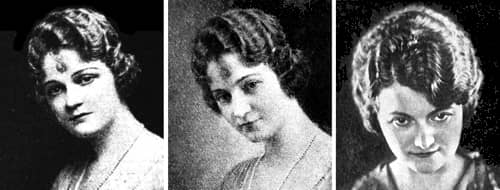
Above: Images of Lucille Young (Fannie Gordon) used on product labels and advertising.
Princess Pat Ltd.
In 1919, Gordon Gordon introduced a new perfume called Princess Pat, named after Princess Patricia of Connaught [1886-1974] a descendant of Queen Victoria. Princess Patricia had married Commander Alexander Ramsay [1881-1972] in February, 1919. In doing so she had relinquished her title and became Lady Patricia Ramsay cementing her popularity in the minds of the general public.
The release of the new perfume was followed by the development of the Princess Pat line of cosmetics. This was a common practice in the beauty industry and something Gordon Gordon had done before with their Mem’ry fragrance. Originally part of the Gordon’s range, Mem’ry cosmetics used the peacock labels developed for later Gordon’s products.
At first Princess Pat was distributed by Gordon Gordon but, in 1923, the Gordons created Princess Pat Ltd. to manage and distribute the Princess Pat line. Fannie Gordon was made the president and advertising manager of the new subsidiary while Martin Gordon became its treasurer. The new company was headquartered at 2709 South Wells Street, Chicago – the same address as Gordon Gordon – and I suspect that Gordon Gordon continued to handle any manufacturing processes that were not fulfilled by private providers.
In 1925, Princess Pat became available in Canada from 107 Duke Street, Toronto, moving to 93 Church Street, Toronto by 1929, by which time the line was also available in Britain. Evidence suggests that Princess Pat may have been sold in some Spanish-speaking countries in the Americas – possibly Cuba and/or Mexico – but this is unconfirmed.
Packaging
The Gordons packaged the Princess Pat line in striking red, black and gold containers. Martin and Fannie also designed and patented a novel powder box which could be repurposed after the powder was finished.
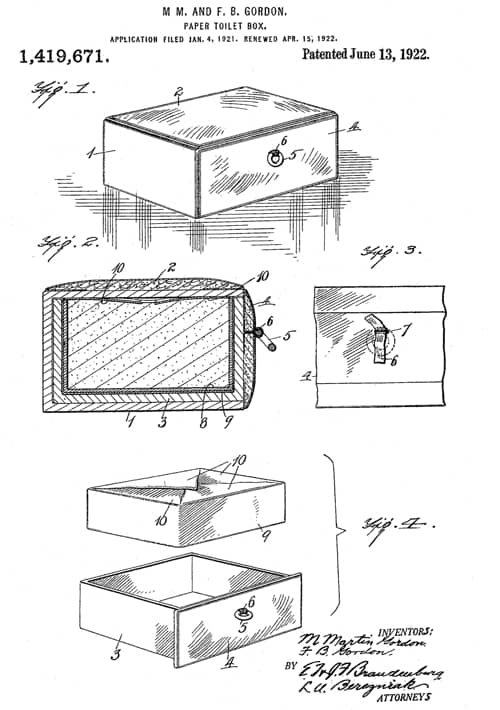
Above: 1922 Designs for a powder box from a patent taken out by Martin and Fannie Gordon (US: 1,419,671, 1922).
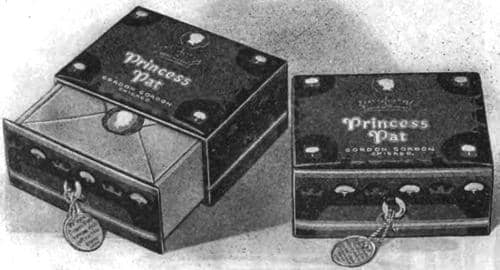
Above: 1921 Princess Pat Treasure Box. There is a Gordon Gordon Chicago mark on the lid as they were distributing Princess Pat cosmetics prior to 1923.
Products
Gordon Gordon’s extensive experience in cosmetics meant that the Princess Pat line contained a range of skin-care and make-up lines.
Skin-care
Central to the Princess Pat skin-care routines was the idea that clogged skin pores were the cause of most complexion problems. The pores were seen as important conduits for the elimination of poisonous wastes and ‘mouths’ through which the skin could be ‘fed’. Both of these ideas were in wide circulation at the time and were used by many cosmetic companies to justify the need for skin foods and astringents.
See also: Skin Foods and Skin Tonics, Astringents and Toners
According to Princess Pat, clogged pores would reduce the ability of the skin to ‘breathe’ and its capacity to ‘absorb food’. It would also lead to a build up of fatty acid – formed from the mixing of sweat with the secretions the sebaceous glands – which would result in acidic and blemished skin.
By enabling the skin to “breathe,” to throw off waste, to be rid of acid, Princess Pat Cream helps the rich red blood circulate freely in the tiny blood vessels, and thus gives you a wonderful natural color.
The acid Princess Pat removes, if allowed to accumulate in the usual fashion, is intensified, resulting of course in skin blemishes. It is about as agreeable to your complexion as might be strong ammonia or sulphuric acid!(Princess Pat, 1923, p. 18)
Also see: Skin Breathing and Acid Creams
These problems could be fixed with the Princess Pat Corrective Treatment which consisted of three skin creams: Princess Pat Skin Cleanser, Princess Pat Cream and Princess Pat Ice Astringent. The Princess Pat Skin Cleanser neutralised the fatty acid and unclogged the skin pores; the Princess Pat Cream built up skin health and the underlying foundation of fat cells; while the Princess Pat Ice Astringent closed the pores without clogging them.
Princess Pat Skin Cleanser: “This cream neutralizes the fatty acid due to the intermingling of sweat and the oil from the sebaceous glands. The skin mouths become glazed over and chocked with this secretion. Soap and water will not cleanse them—nor will ordinary creams.”.
Princess Pat Cream: “In this cream are included the elements in which eight years of research indisputably proved the exact elements to build skin health. It is this cream which gives the skin “tonicity.” It penetrates the glands and allays irritation. It is brought close to the nerve fibres of the inner skin, which like all the nerve structure requires vitalization. It goes directly into the sebaceous glands which open directly at the skin surface and lead directly to the foundation fat cells beneath the outer skin.”
Princess Pat Ice Astringent: “The object of Princess Pat Ice Astringent is to give the skin a final stimulation. It contracts the skin mouths—as they should be contracted, without sealing or plugging them up! It acts like ice—is cool and refreshing—but has not the disadvantage of ice, which is too pronounced in its action on the skin.”
Where most other cosmetic companies would use a liquid astringent directly after a cleanser, the Princess Pat Ice Astringent was a cream applied after and directly over the Princess Pat Cream. Both creams were then removed together, a process referred to as the Princess Pat Twin Cream Method.
The reason given for combining the two creams goes back to the idea that the skin can be fed through the skin pores. If the Princess Pat Ice Astringent was applied before the Princess Pat Cream it would close the ‘mouths’ of the skin and make it difficult for the Princess Pat Cream to penetrate. Applying the astringent after the cream would give the skin time to absorb the ‘nourishing and vitalizing oils’ in the Princess Pat Cream but close the pores so that they would not become clogged with powder. In addition, any creamy residue remaining on the face would make a suitable powder base, eliminating the need for a vanishing cream.
See also: Vanishing Creams
The Princess Pat Corrective Treatment differed slightly from morning to night. In the evening, the Princess Pat Ice Astringent was omitted and the Princess Pat Cream left on overnight. The morning treatment replaced the Princess Pat Skin Cleanser with a quick rinse in cool (not cold) water.
There were also suggestions for specific problems such as wrinkles, lines around the eyes, and double chins. These treatments were all perfunctory and simply required the use of extra Princess Pat Cream with or without a little massaging. Although manipulating (spreading) skin creams was necessary, Princess Pat did not considered massage important except for the Double Chin Treatment. In massage terms only effleurage was needed – applied upwards and outwards as usual.
It is the Princess Pat corrective Creams which accomplish results—not massage. The purpose of manipulation is to bring the cleansing, healing, soothing and tissue building elements in closer and better contact with the tiny skin mouths. Remember these are no ordinary creams. While they resemble in appearance creams you have used before, the similarity ends with appearance!
(Princess Pat, 1923, p. 14)
Also see the company booklet: The Promise of a Princess
Despite claims that the Princess Pat corrective creams were something different, available evidence suggests that the Princess Pat Skin Cleanser and the Princess Pat Cream were both cold creams made with beeswax, mineral oil, and ozokerite wax with the latter also including lanolin, a well-known ‘skin food’. The Princess Pat Ice Astringent seems to have been a vanishing cream with an added aromatic compound to provide a cooling effect.
These fundamentals were eventually acknowledged by Princess Pat when, towards the end of the 1920s, it began calling its Princess Pat Skin Cleanser ‘The Modern Cold Cream’ and its Princess Pat Ice Astringent ‘The Ideal Vanishing Cream’.
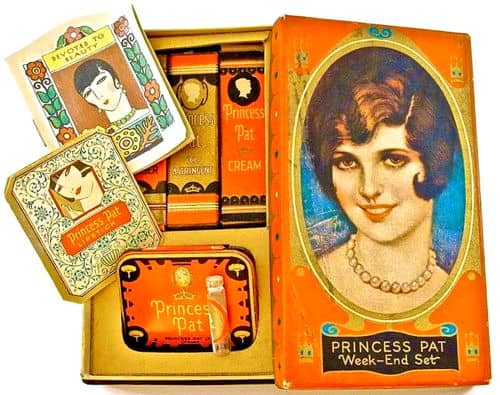
Above: Princess Pat Week-End Set. This trial product set was available through most of the 1920s in various formats for 25¢.
The company eventually went further than this as, by 1931, it had added the words Cold Cream to the Princess Pat Skin Cleanser, Skin Food to the Princess Pat Cream and Vanishing to the Princess Pat Ice Astringent labels.
By 1929, Princess Pat had also introduced a liquid form of its Ice Astringent. Unlike the Princess Pat Ice Astringent Cream, the Princess Pat Liquid Ice Astringent was used like a standard skin tonic to close the pores of the skin after the skin was cleansed with Princess Pat Cleansing (Cold) Cream. The probable reason for this change in strategy was the introduction of Creme Summertan (a tinted foundation) as an alternative base for face powder. It was used on darker skin tones in place of Princess Pat Ice Astringent (Vanishing) Cream.
In 1927, Princess Pat added Lemon-Almond Lotion to its skin-care range. Originally introduced as a hand lotion to whiten and soften the hands, Princess Pat also suggested that it could be used to lighten the face. In the 1930s, it would be recommended as a general body balm and as a soothing agent for chapped or sunburnt skin.
Later skin-care additions included the Princess Pat Muscle Oil and Princess Pat Egg Masque introduced by 1932. Both were staples of Beauty Culture in the 1920s and 1930s.
Princess Pat Muscle Oil – and the later Princess Pat Irradiated Muscle Oil – were to be used in places where facial contours were sagging or where lines and wrinkles were developing. The Princess Pat Egg Masque was to be left on the face for fifteen to thirty minutes once or twice a week, preferably over a film of Princess Pat Muscle Oil.
Princess Pat Muscle Oil (Double Strength): “[A]id for the underlying muscle strength must go deep. Penetrative indeed must be the effect that make firm tired, drooping muscles.”
Princess Pat Egg Masque: “[L]eaves the skin delightfully clear and soft. It stimulates circulation and gives the cheeks natural color. Its effect is immediate and wonderful in smoothing out lines and wrinkles.”
See also: Muscle Oils
By 1936, wrinkles were also being treated with a new product, the Princess Pat Anti-Wrinkle Cream.
Make-up
The early Princess Pat make-up range consisted of a face powder (both loose and compact), a compact rouge and a lipstick.
Princess Pat Face Powder: The powder was made with an almond base which the company advertised as being superior to rice-based powders as it did not block the skin pores. However, Princess Pat made no mention of its ‘superiority’ over other powders made from minerals like calcium carbonate and talc nor did they mention other vegetable powders such as wheat, corn or potato.
When you use ordinary powder—with a rice base—the finely pulverised rice fills up the skin mouths. Perspiration and oil from the sebaceous glands moisten it. The body temperature supplies the heat. Then, within the skin mouths, the rice particles react just as they do to heat and moisture—they swell! Can you imagine a better way to cause “coarse pores?”
Furthermore, rice ferments. This helps along the production of fatty acid. Is it any wonder that so many women find that the use of powder causes “smarting?” Now you know the scientific reason.(Princess Pat, 1923, p. 23)
By 1927, Princess Pat had also added a light-weight powder in a round powder box, the original powder then becoming known as medium weight.
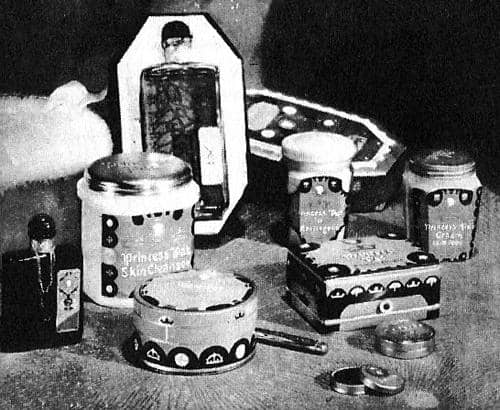
Above: c.1928 Princess Pat Products with round (light weight) and oblong (medium weight) powder boxes.
The face powder originally came in four shades – Flesh (light rose), White, Olde Ivory (flesh), and Brunette (gypsy olive) – with Ochre, and Mauve (1928), and Summertan (1929), later called Tan, added subsequently. These new shades helped accommodate the darker skin tines generated by the vogue of sunbathing that developed through the 1920s and also complemented the new shades of Princess Pat Rouge. By 1940, the face powder was being sold in Natural, Rose Pearl, Rachel, Peach Glo, Copper Glo, and Gypsy shades.
Princess Pat Rouge: Initially, Princess Pat made only one shade of rouge called English Tint. This compressed rouge also seems to have been made using almond powder and it was marketed as natural, undetectable and perfect for every skin tone.
Princess Pat Tint comes in only one shade—and in this fact lies the clue to this seeming mystery of perfect color . . . Princess Pat Tint is rather an orange color in the compact, but when applied, changes to the exact natural color that belongs to your complexion . . . Princess Pat Tint does not run or streak under any conditions. It will even withstand surf-bathing in the ocean. Yet it can be removed even more readily than ordinary rouge with a touch of cream or soap and water. Remember it is a dry tint, not a paste or liquid.
(Princess Pat, 1923, p. 25)
English Tint was a changeable rouge, most likely coloured with bromo acids. Like a changeable lipstick, the rouge looked orange in the compact (due to eosin) but went red when applied to the cheeks. The change in colour required an acidic environment and would not have worked if the Princess Pat face creams had completely neutralised the skin’s natural acidity.
Although they maintained the Princess Pat English Tint the company quickly introduced other shades starting with Medium, and Vivid (1925); Squaw, No. 18 Theatre, and Nite (1927); and Summertan (1929). By 1932, Summertan was known simply as Tan, No 18 Theatre as Theatre, and Princess Pat had added a new Gold shade.
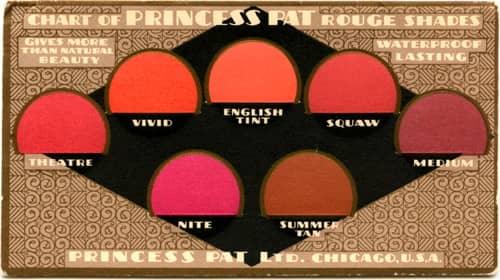
Above: Princess Pat rouge shades.
These additional shades were added to make allowances for the increased level of suntanning, the greater use of colour, and the growing use of make-up through the 1920s and 1930s. However, rather than match its rouges with a woman’s skin, hair or eye colour, Princess Pat suggested they be coordinated with clothing and to combine two shades to produce a new tone when necessary.
Remember, skin tone is no longer a limitation. Now you can live up to the most glowing red gown, and yourself scintillate, sparkle because the all-important color harmony of complexion with dress has been achieved. For all shades of red, use Princess Pat Vivid, or Princess Pat Squaw. Even the palest blonde—one who has thought she simply could not wear bright red—is beautiful in flaming colors through the use of Vivid or Squaw to set the right color note in the cheeks. For gowns of purple, violet, blue use Squaw, Theatre or Medium. When you wear yellow, orange, green, your cheeks are a golden flame with Princess Pat English Tint. With soft pastel costumes, achieve the complexion note of cool, delicious serenity with Princess Pat Medium or Theatre. For evening wear, use Princess Pat Nite. This indeed is a marvelous shade; since it responds as gloriously to artificial light as the most perfect daytime rouge does to sunlight.
Perhaps you’ll find the greatest fascination lies in blending one or more shades of Princess Pat Rouge upon your skin … Vivid, for instance, with a little touch of Nite to give marvelous, pearly iridescence under artificial light. Or Squaw, with a touch of English Tint to produce an original personal hue. Or Squaw with a touch of Nite violet-shaded, mysterious, compelling. Here is individuality plus; for whatever your requirements to bring out utmost beauty, Princess Pat rouge shades are adequate.(Princess Pat advertisement, 1929)
See also: Colour Coordination and Make-up, Personality and Types
Princess Pat Lipstick: The lipstick was introduced in a simple push-up, gold-coloured metal container. It only came in a single colour, later called Natural. In 1925, the Vivid shade was added so that the lipsticks could be colour coordinated with the new rouge shades – English Tint or Medium shades of rouge to use the Natural lipstick; Vivid rouge to use the Vivid lipstick.
In 1927, the company introduced Princess Pat Lip Rouge, an indelible in English Tint, Dark, Light and Medium shades.
Princess Pat Lip Rouge: “[I]t does what no other lip rouge has ever done. Princess Pat Lip rouge colors that inside moist surface of lips as well as outside . . . Keeps lips soft and free of chap and dryness. Permanent.”
The lip rouge was probably added so that it could be used in a new container developed and patented by Fannie Gordon (US Patent: 1,759,451, 1930). Described as a loose powder pencil it consisted of a powder puff with an inner metal dispenser. The dispenser – which came in gold or silver – had two compartments, one for dispensing powder the other containing lip rouge. Called the Tap-It, or the Loose Powder dispenser it also went on sale in 1927.
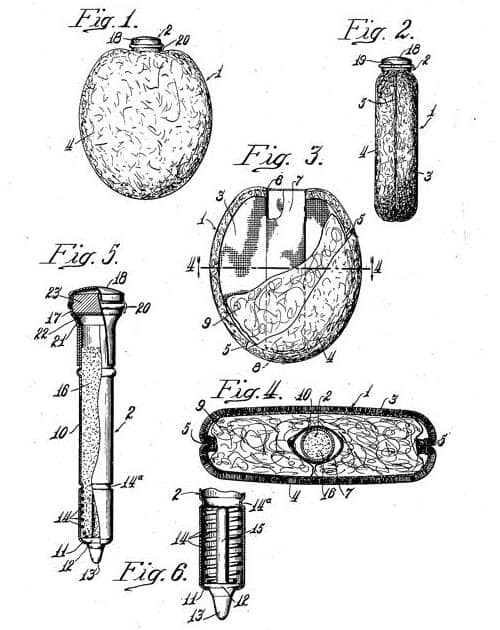
Above: 1930 Designs for a cosmetic appliance developed by Fannie Gordon (US Patent: 1,759,451, 1930) which would be sold as a Loose Powder Pencil (Tap-It).
In 1939, Princess Pat introduced a modified form of this dispenser they called the Vaniteen which did away with the surrounding puff and brocade cover. The gold-finished container was shorter and wider than the original. It still had a compartment for face powder but the top compartment now held a compressed rouge with a small puff. Unfortunately, the Vaniteen was rapidly becoming a solution in search of a problem. The development of compressed powder creams and liquid make-up would depress sales of loose face powders after the Second World War.
The introduction of a lip rouge in 1927 seems to have been accompanied by a new swivel lipstick in an enamelled red, black and gold case. Like the lip rouge this new lipstick came in English Tint, Dark, Light and Medium shades. The cheaper original push-up lipstick still only came in Vivid and Natural shades.
Creme Summertan: This coloured foundation was probably introduced in 1929 when Summertan shades of face powder and rouge were released. It would have made darker shades of face powder more effective and was described as “indispensible for tan make-up”. By 1932, the company had extended this idea adding Princess Pat Tinted Foundation in Olde Ivory, Flesh, White, Brunette, Ochre, Tan, Mauve, and Rose Cameo shades.
Eye make-up: Probably developed in 1931, the eye make-up range included: Princess Pat Eye Shadow (cream and powder) in Gray, Blue, Green, Brown, and Purple shades with an additional Black shade in the cream (moist) form; Princess Pat Mascara, a traditional cake mascara in Black, and Brown shades; and Princess Pat Eyebrow Pencil also in Black, and Brown.
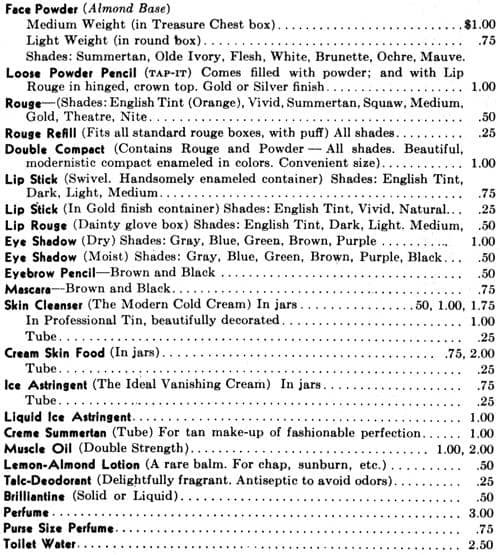
Above: 1931 Princess Pat complete product list.
Nail cosmetics: Probably introduced in 1932, the range included: Princess Pat Liquid Nail Polish in Colorless, Natural, Coral, and Dark shades; Princess Pat Nail Polish Remover; Princess Pat Cuticle Remover; Princess Pat Cuticle Oil; and Princess Pat Nail White.
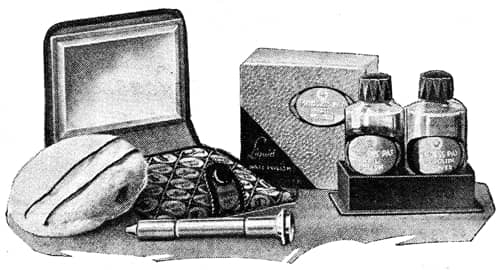
Above: 1933 Princess Pat Tap-It as well as Nail Polish and Remover.
Other cosmetics sold by Princess Pat were Princess Pat Toilet Water and Princess Pat Two-Purpose Talc. The later was to be used as a general deodorant but could also be dusted on napkins for ‘personal daintiness’. A later addition was Princess Pat Brilliantine, a hair preparation sold in liquid and solid formulations.
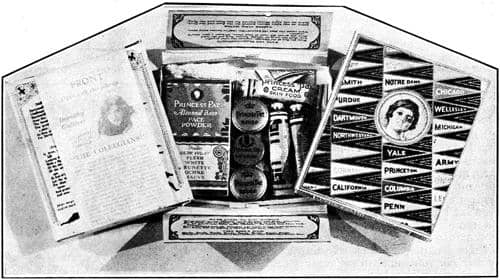
Above: 1929 Princess Pat Collegian Kit. Marketed to college students it included samples of Princess Pat cosmetics and product information along with the words to the songs used by various American colleges, such as Yale, Princeton, Columbia and Notre Dame.
Also see the company booklets: This Exquisite Beauty and For You – Exquisite Beauty
1930s
In 1931, Princess Pat, like many other cosmetic companies at the time, began updating the packaging of its cosmetics. Although some items took a while to change there was a gradual move towards simpler container shapes, an increased use of many-coloured pastel shades on the labels and a replacement of geometric patterns with softer floral emblems. The white, glass, square-bottom glass jars with metal lids that held many of its skin creams were also gradually replaced with more modern-looking round jars with black, and later white, lids. One of the first products to sport this new look was the Princess Pat Anti-Wrinkle Cream.
In 1932, the Gordons celebrated the silver anniversary of their marriage and the founding of Gordon Gordon. The adverse economic conditions that the company had experienced since 1929 were difficult but, as yet, the Gordons had not cut the salaries of their staff or ruthlessly slashed operating expenses (AP&EOR, 1932). Instead they concentrated on expanding the Princess Pat line and developing new ways to generate sales such as advertising on radio.
Starting with five-minute broadcasts on a Chicago radio station in 1932, by 1935, Princess Pat was sponsoring the ‘Princess Pat Dramas’, weekly broadcasts through the NBC network. As part of the program, Fannie Gordon, known as Patricia Gordon, provided cosmetic advice and information about Princess Pat products. Princess Pat had previously combined fiction and beauty in its ‘Modern Story’ magazine.
See also: Modern Story Magazine No.2
Princess Pat appears to have generated most of its sales from its make-up, particularly its rouges. During the 1930s it promoted these as ‘Duo-Tone’ and continued to insist that all of its rouge shades could be used on any skin and would harmonised with whatever a woman was wearing.
“Duo-Tone” means that Princess Pat rouge is composed of two distinct tones, perfectly blended into one by an exclusive, secret process. Thus each shade of Princess Pat rouge possesses a mystical underglow to harmonize with the skin, and an overtone to give forth a vibrant color. Too, Princess Pat rouge changes on the skin, adjusting its intensity to your individual need.
(Princess Pat advertisement, 1931)
This claim was simply a reflection of the fact that the rouge contained a changeable bromo acid dye – the ‘mystical underglow’ – as well as coloured pigments – the ‘overtone’.
Despite its best efforts it would appear that Princess Pat gradually lost ground during the 1930s. In 1941, like many other American cosmetic companies it was hit with a number of cease and desist orders by the Federal Trade Commission (FTC) acting under the provisions of the Food, Drug and Cosmetic Act (FD&CA) passed in the United States in 1938.
The FTC targeted Princess Pat cosmetics that made false statements and representations, so products such as Princess Pat Face Powder, Princess Pat Muscle Oil, Princess Pat Skin Food Cream, Princess Pat Cleanser, and Princess Pat Anti-Wrinkle Cream were issued with orders. Princess Pat was not alone in this regard; companies such as Helena Rubinstein, Dorothy Gray, Richard Hudnut and Elizabeth Arden were all treated in a similar fashion.
Two years later, the company got another setback when a fire destroyed the company’s main manufacturing and storage plant causing damage estimated at US$250,000. America by this time was at war, so replacing much of this material must have been difficult.
Liquid Liptone
A major saving grace for Princess Pat was the introduction of Liquid Liptone in 1938. Developed by Milton Norman Klimist [1902-1975] it became the main focus of Princess Pat advertising after the Second World War. Klimist was a pharmacy graduate from the University of Illinois and may have come to work for the Gordons in the early 1920s. Both the cosmetic and the dispenser were covered by patents (US Patent: 2,230,063, 1941 and US Patent: 2,158, 901, 1939).
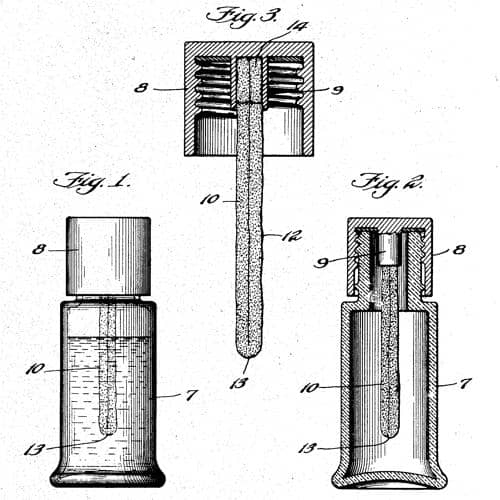
Above: 1939 Patent designs used for the Liquid Liptone applicator (US Patent: 2,158,901, 1939) invented by Max Martin Gordon.
Princess Pat called Liquid Liptone a liquid lipstick becoming, as far as i can tell the first company to do so. Made with ethyl cellulose it formed a moisture-proof, smear-proof coating when applied to the lips that required a special remover to take it off. It was originally introduced in English Tint, Light, Topic, Parisian, Medium, and Regal shades. Clear was added in 1948 so the product could also be used to seal traditional lipsticks. In the very late 1950s, the formula for Liquid Liptone was also used by Princess Pat to produce X-Ray Guide, a product used to mark the skin in radiation therapy.
See also: Liquid Lipsticks & Sealers
Liquid Liptone was sometimes advertised in conjunction with Cheektone (1940). Sold in a round plastic container, Cheektone appears to have be made primarily with dyes rather than pigments. This apparently emboldened Princess Pat to claim that it was not a rouge.
An entirely new idea – and it’s wonderful. As much color as you want . . . just a tint, or a deep, deep blush – but absolutely natural. No “rouge-look” at all because it isn’t rouge. It’s a creamy precious compound in the plastic jar – and when applied it stays on, the day through. Here is the natural, fresh look you need to go with the new clothes.
(Princess Pat advertisement, 1941)
Liquid Liptone was the last major innovation from Princess Pat and this is where my interest in the company concludes. The Princess Pat line limped on through the 1950s but after her husband died in 1955, I imagine Fanny (Patricia) Gordon found it difficult to continue on alone.
Around 1958, the company underwent a change of address, moving to 31 West 47th Street, New York, so it is possible that it was sold at this time. It was still in business in 1966 when S. Victor Berke – a marketing expert and executive vice-president of the company – suggested that the line was to be modernised and expanded (AP&EOR, 1966) but the hoped for revitalisation did not happen and the brand disappeared.
Timeline
| 1907 | Gordon Gordon Ltd. founded. |
| 1919 | New Products: Princess Pat Perfume. |
| 1923 | Princess Pat Ltd. established at 2701 South Park Avenue, Chicago. |
| 1924 | Headquarters moved to 2709 South Wells Street, Chicago. |
| 1925 | Princess Pat sold in Canada. |
| 1927 | New Products: Lemon-Almond Lotion; Princess Pat Lip Rouge; and Tap-It container. |
| 1929 | Canadian factory opened in Toronto. New Products: Collegian Kit. |
| 1931 | Princess Pat line repackaged. |
| 1932 | Princess Pat begins radio advertising (U.S.). Gordon Gordon (London) Ltd. takes over the distribution Princess Pat in Britain. |
| 1938 | New Products: Liquid Liptone. |
| 1939 | New Products: Vaniteen. |
| 1940 | New Products: Cheektone. |
First Posted: 8th August 2017
Last Update: 17th April 2024
Sources
The American perfumer & essential oil review. (1906-1955). New York: Robbins Perfumer Co. [etc.].
Princess Pat. (1923). The promise of a princess [Booklet]. Chicago, IL: Author.
Princess Pat. (c.1930). This exquisite beauty [Booklet]. Chicago, IL: Author.
Princess Pat. (c.1932). For you – exquisite beauty [Booklet]. Chicago, IL: Author.
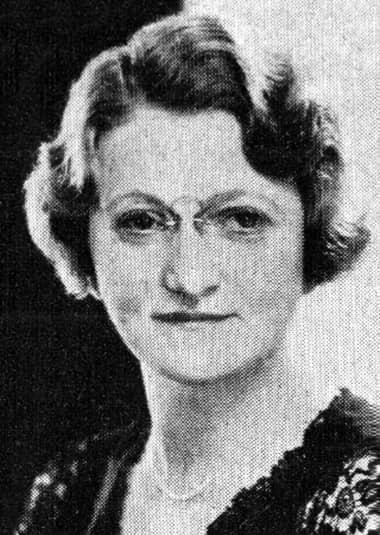
Fannie (Patricia) Gordon (née Berezniak) [1887-1960].
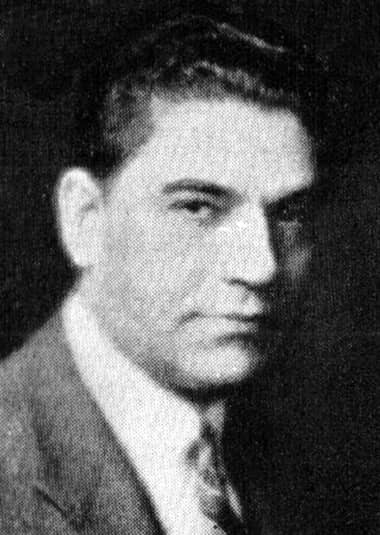
Max Martin Gordon [1886-1955].
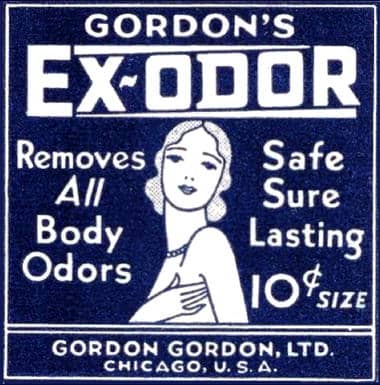
Gordon’s Ex-odor Deodorant.
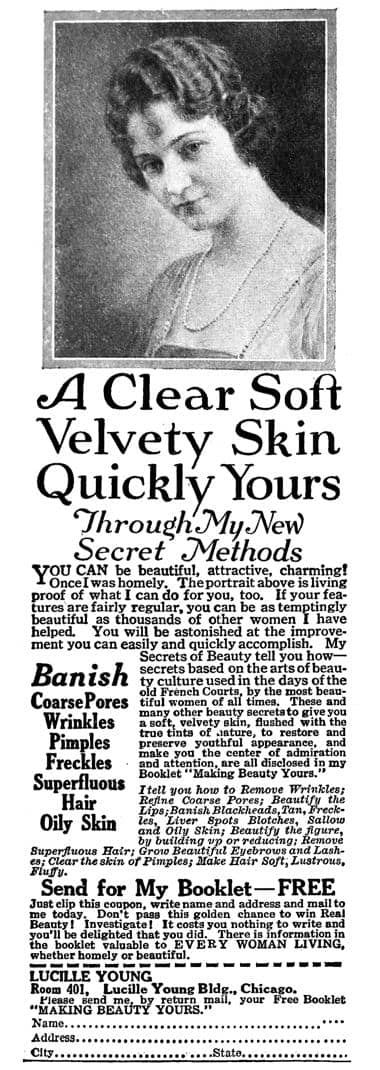
1923 Lucille Young from Gordon Gordon.
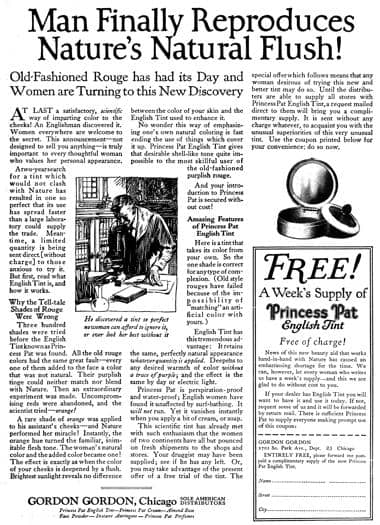
1923 Princess Pat English Tint.
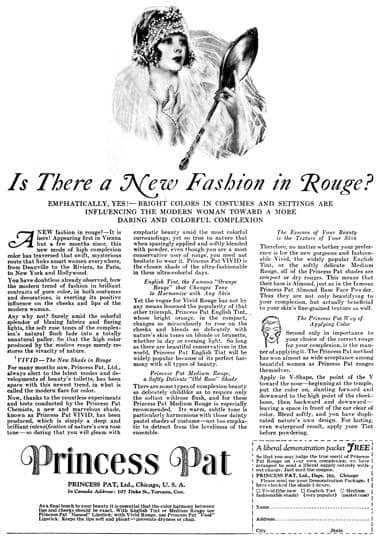
1925 Princess Pat Rouge.
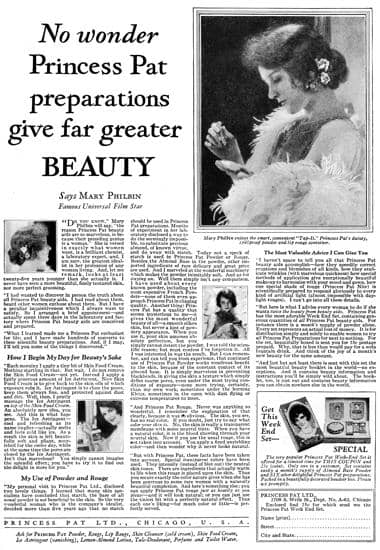
1927 Princess Pat. The top right image shows the actress Mary Philbin [1902-1993] using the Princess Pat Tap-It spill-proof powder and lip rouge container. After removing the dispenser from the powder puff powder was tapped on the puff and then applied to the face. After powdering, the lips could be touched up using lip rouge from the top compartment before the container was returned to the puff. The puff had to be replaced into its brocade bag before being returned to a purse.
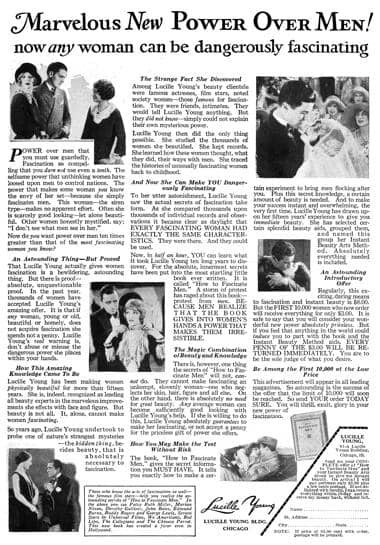
1928 Lucille Young with mention of her booklet ‘How to Fascinate Men’.
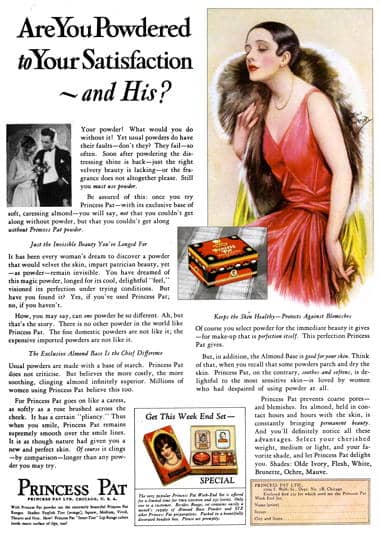
1928 Princess Pat Face Powder.
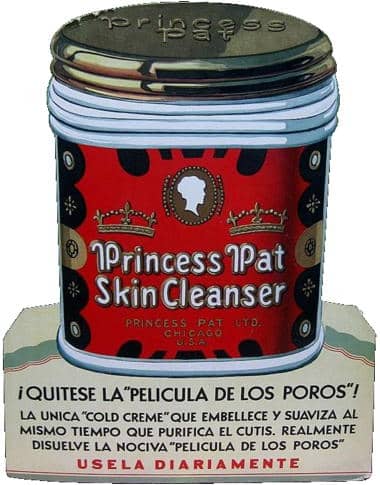
Princess Pat Skin Cleanser. The language on this display stand suggests that Princess Pat was sold in some Spanish-speaking countries in the Americas in the 1920s.
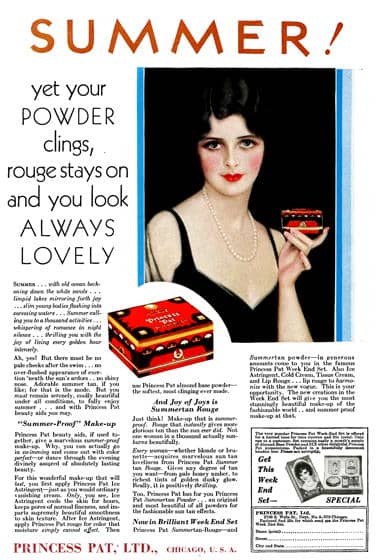
1929 Princess Pat Powder and Rouge in Summertan shade.
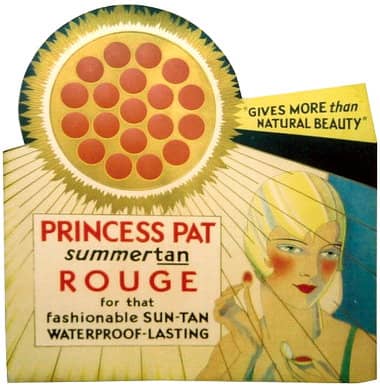
Princess Pat Summertan Rouge display stand.
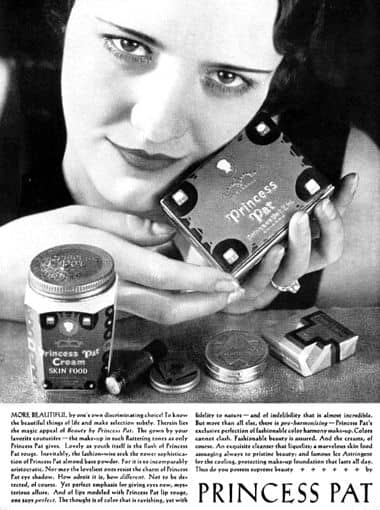
1931 Princess Pat. The Princess Pat Cream is now labelled Skin Food. The box on the bottom right is Princess Pat Eye Shadow.
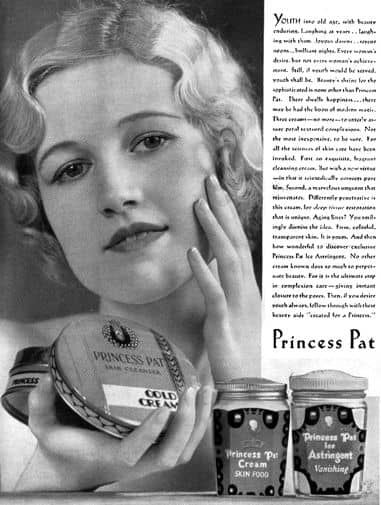
1931 Princess Pat. The Princess Pat Cleansing (Cold) Cream is now available in a lage economy tin.
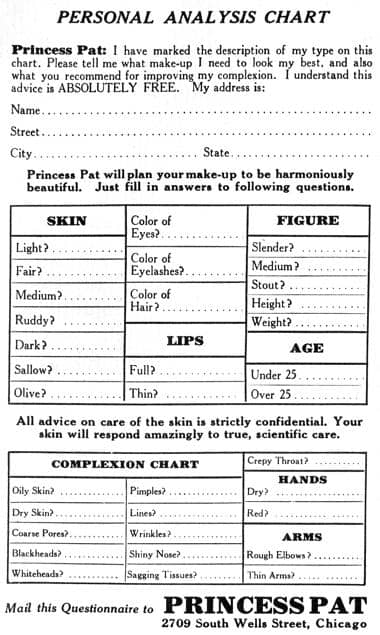
1931 Princess Pat Personal Analysis Chart.
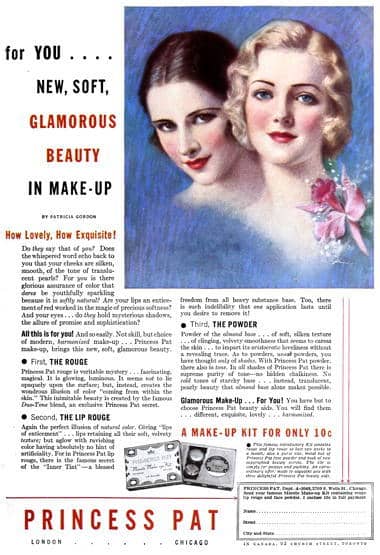
1932 Princess Pat. Due to the depressed economic conditions the Week-end Set (25¢) offered by Princess Pat in the 1920s has been replaced by a cheaper Make-up Kit (10¢).
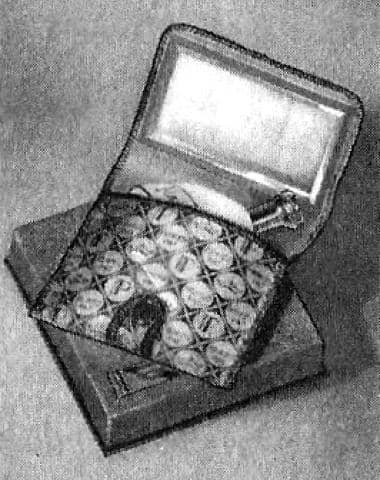
c.1932 Princess Pat Vanity (Tap-It).
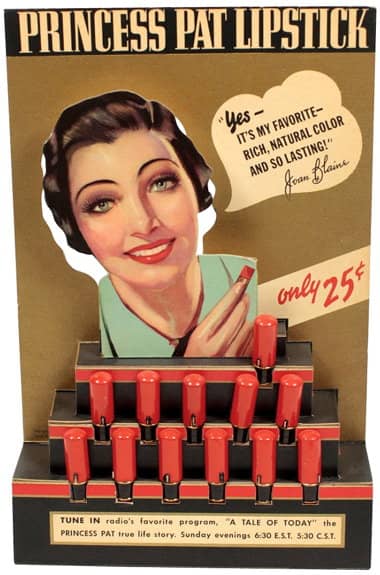
Princess Pat Lipstick display stand. The advertised ‘A Tale of Today’ radio program ran in various formats between 1933 and 1939.
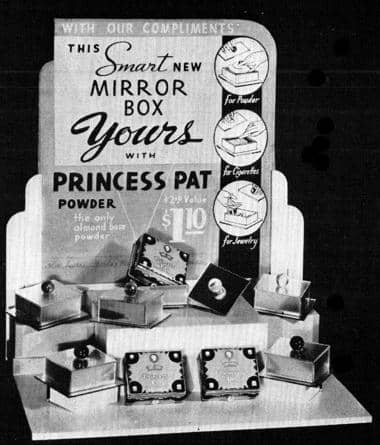
1935 Princess Pat Face Powder display stand.
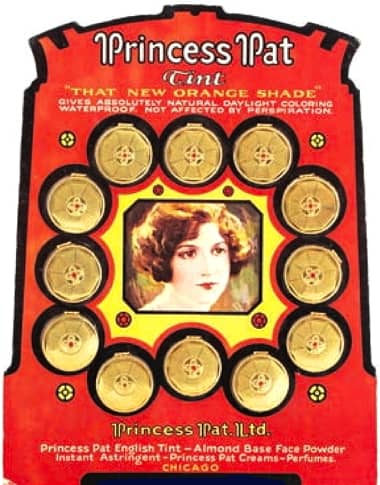
Princess Pat Tint display stand. These compacts were introduced in 1937.
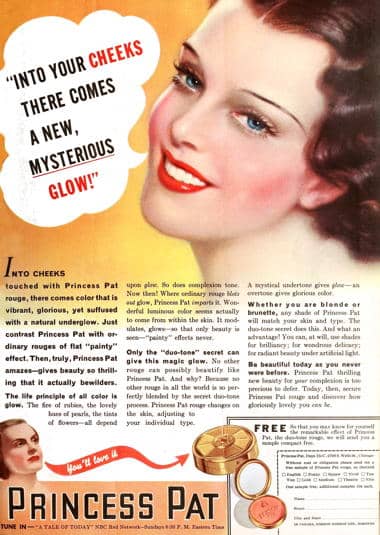
1937 Princess Pat Rouge.
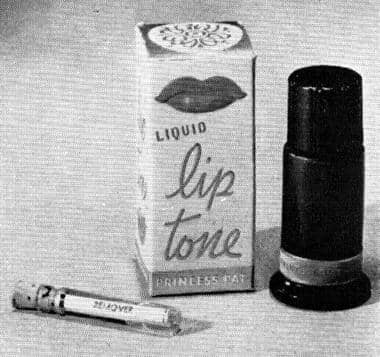
1938 Princess Pat Liquid Liptone and Remover. Princess Pat called the product a liquid lipstick.
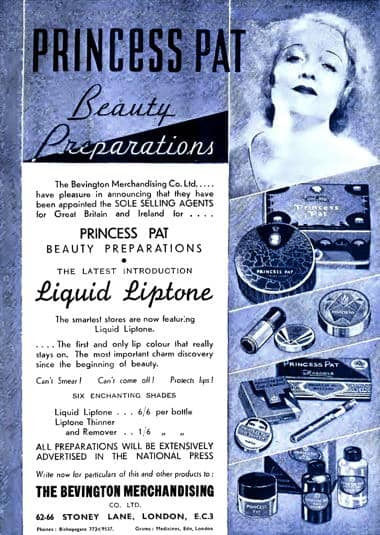
1939 Princess Pat product range (British).
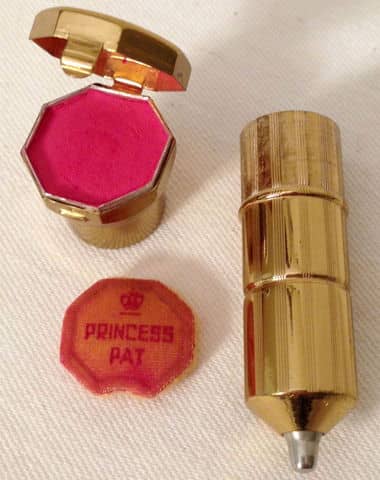
Princess Pat Vaniteen.
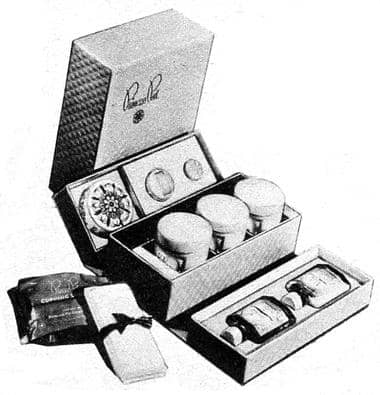
1941 Princess Pat Keep-Neat Kit. Although sold a decade after 1931 it shows the sort of packaging changes that took place during the 1930s.
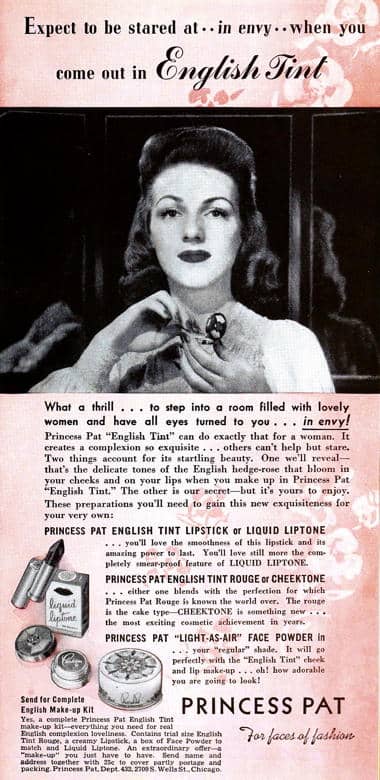
1942 Princess Pat.

1945 Princess Pat.
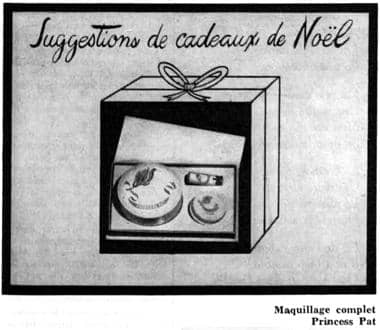
1946 Princess Pat (Canada).
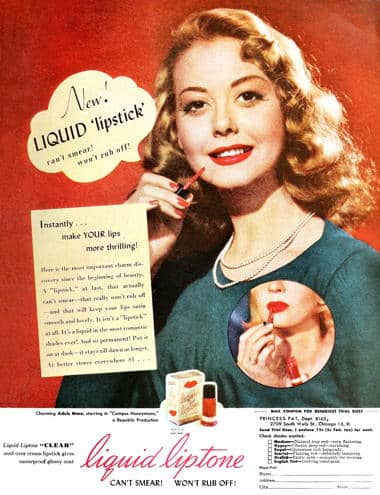
1948 Princess Pat Liquid Liptone.
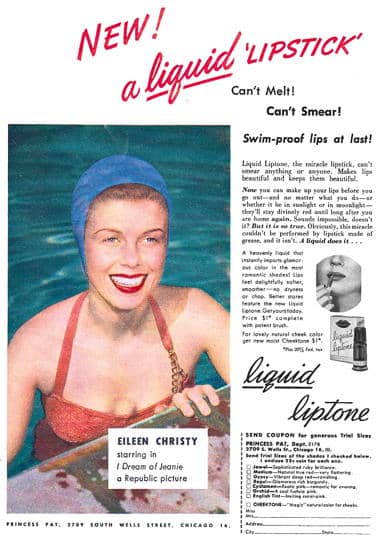
1952 Princess Pat Liquid Liptone, liquid lipstick.

1958 Princess Pat.
